
Centruroides is a genus of scorpions of the family Buthidae. Several North American species are known by the common vernacular name bark scorpion. Numerous species are extensively found throughout the southern United States, Mexico, Central America, the Antilles and northern South America. Some are known for their interesting patterning or large size ; most if not all fluoresce strongly under ultraviolet illumination, except after moulting. They contain several highly venomous species, and fatalities are known to occur. The venom of the Mexican scorpion Centruroides limpidus limpidus contains the neurotoxins Cll1 and Cll2.

Euscorpius is a genus of scorpions, commonly called small wood-scorpions. It presently contains 65 species and is the type genus of the family Euscorpiidae – long included in the Chactidae – and the subfamily Euscorpiinae.
The taxonomy of scorpions deals with the classification of this predatory arthropod into 13 extant families and about 1,400 described species and subspecies. In addition, 111 described taxa of extinct scorpions are known.
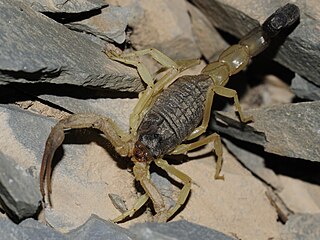
Hottentotta is a genus of scorpions of the family Buthidae. It is distributed widely across Africa, except for most of the Sahara desert. Species in the genus also occur in the Middle East, the Arabian Peninsula, southeastern Turkey, Iraq, Iran, Afghanistan, Pakistan, India, Nepal, Cape Verde Islands, and Sri Lanka (introduced).
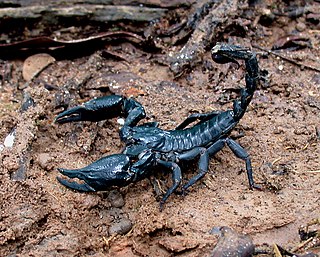
Heterometrus, whose members are also known by the collective vernacular name giant forest scorpions, is a genus of scorpions belonging to the family Scorpionidae. It is distributed widely across tropical and subtropical southeastern Asia, including Indonesia, Brunei, Malaysia, Myanmar, Philippines, Singapore, Cambodia, Laos, Thailand, Vietnam, India, and China (Hainan). It is notable for containing some of the largest living species of scorpions.

Leiurus is a genus of scorpion of the family Buthidae. The most common species, L. quinquestriatus, is also known under the common name Deathstalker. It is distributed widely across North Africa and the Middle East, including the western and southern Arabian Peninsula and southeastern Turkey. At least one species occurs in West Africa.

Vaejovidae is a family of scorpions, comprising 25 genera and 227 species, found in North America. The species of the genus are found in Mexico and the southern United States, and Paruroctonus boreus is found in Canada and is the northernmost species of scorpion in the world.
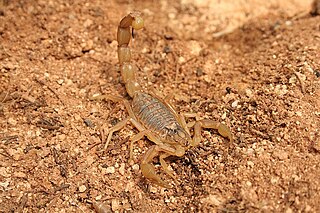
Buthus is a genus of scorpion belonging and being eponymous to the family Buthidae. It is distributed widely across northern Africa, including Morocco, Mauritania, Algeria, Tunisia, Libya, Egypt, Senegal, Guinea-Bissau, Nigeria, Sudan, Somalia, Ethiopia, Djibouti, as well as the Middle East, including Israel, Palestine, Jordan, Lebanon, Iraq, Yemen, and possibly Saudi Arabia and southern Turkey. Its European range includes the Iberian Peninsula, southern France, and Cyprus.
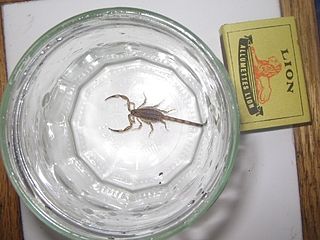
Isometrus is a genus of scorpion belonging and being eponymous to the family Buthidae. Some species are currently assigned to the genus Reddyanus.
Mesobuthus is an Asian genus of scorpions in the family Buthidae.

Scorpionidae is a family of burrowing scorpions or pale-legged scorpions in the superfamily Scorpionoidea. The family was established by Pierre André Latreille, 1802.

Brachistosternus is a scorpion genus in the Bothriuridae family. B. ehrenbergii is the most cited species in the genus. The genus is distributed in Argentina, Bolivia, Brazil, Chile, Colombia, Ecuador, Paraguay, and Peru.

Urodacus is a genus of scorpion belonging to the family Urodacidae. It was described by German naturalist Wilhelm Peters in 1861. The type species is U. novaehollandiae. Its species are native to Australia, and dig burrows. The genus was placed in its own family in 2000. Before this, the group had been a subfamily Urodacinae within the family Scorpionidae.

Javanimetrus cyaneus, the Asian blue forest scorpion, is a species of scorpions belonging to the family Scorpionidae.

Charmus laneaus is a species of non-venomous scorpion in the family Buthidae endemic to Sri Lanka.
Alpiscorpius gamma is a species of scorpion found in parts of Central and Southern Europe. Its body reaches the length of 32 mm and is darkly pigmented, but is largely indistinguishable from closely related species with which it forms the »mingrelicus complex«. The animal is not considered aggressive and has mild venom, so it is not dangerous to humans.
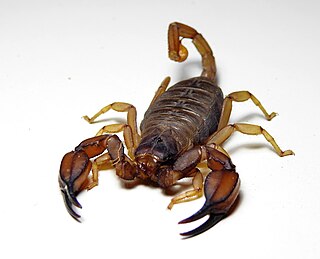
Urodacidae is a family containing two genera of scorpions, both of which are endemic to Australia. It was first described by British zoologist Reginald Innes Pocock in 1893. Formerly a subfamily (Urodacinae) of the Scorpionidae, it was later raised to family rank. Its sister taxon is the monotypic family Heteroscorpionidae, the species of which are confined to Madagascar.
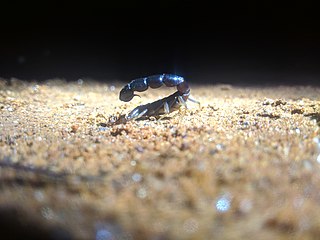
Buthoscorpio is a genus of scorpions in the family Buthidae.
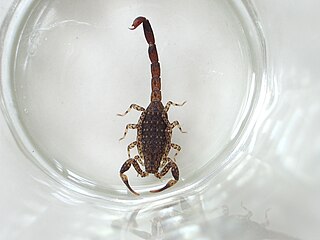
Lychas is a genus of scorpions belonging to the family Buthidae. It is one of the most widespread genus of the scorpions, where the species are found throughout in Africa and Seychelles, and in the Oriental region from India to Melanesia.
Alpiscorpius is a genus of scorpions in the family Euscorpiidae that was first described by Benjamin Gantenbein, Victor Fet, Carlo Largiader & Adolf Scholl in 1999.
















